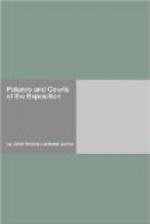Lawson cypress.
Libocedrus decurrens (incense cedar).
Acacia floribunda.
Acacia latifolia.
Albizzia lophantha.
Abies menziesü (fir).
Picea Engelmanni (spruce).
Picea excelsa (from Norway) (spruce).
Pittosporum.
Rhododendrons (notice how they work upon the pink walls) (for color).
Cinerarias (for color).
Cyclamen (for color).
Dracaena indivisa (cabbage palm).
Woodwardias.
Japanese strawberry.
Notice Mr. McLaren’s devices for covering the ground.
The lophantha lawn, it might be called, is an artificial device for producing a most lovely effect. The tree is stripped of all branches until it has attained the height of four feet, the top being trained and flattened into a head five feet across. The trees are placed close enough together so that the tops interlace, producing thereby a continuous green surface.
The veronica, buxifolia is the light green border at the side and in front of the Palace of Varied Industries.
Achanea from New Zealand and Australia is used on the banks and accords most harmoniously with the albizzia lophantha.
The abelia rupestris is the red leafed plant with pink blossoms.
Peonia moutan daikaqura is the peony.
Since the small plants in front of the permanent shrubs are changed periodically, a list of everything planted is of course out of the question.
The technical names are suggested with a few of the trees and shrubs so that you can continue this line of work for yourself.
Since the botanical names are placed on the plants in many places you can easily find what you seek.
The Palace of Manufactures and also The Palace of Liberal Arts (Since they are alike.)
The portal is Spanish Renaissance with grill work. Notice the pastel pink, turquoise blue and burnt orange on this portal. This coloring is a means of strongly accenting this fine architectural feature.
The panel (representing the making of glass, metal work, textiles, statuary, etc.), as well as the female figure holding the spindle and the male with the sledge-hammer, are by Mahonri Young of Salt Lake City, Utah.
The wall niches show elephants and lions used alternately — a fine oriental touch. The heads are used as fountains.
“Acroterium” is the Victory on the gables, many times repeated. It is the work of Frank Edwin Elwell, curator of Ancient Art, at the Metropolitan Museum of New York.
Viewing the figure from the side, you are reminded of the Victory of Samothrace. She is noticeably beautiful against the late afternoon sky and also against the blue morning sky.
You will notice that the flora is just the same in the main in front of these buildings as it was in front of the others you have seen, the grass lawn here taking the place of the albizzia lophantha.
Sweet peas, daffodils, rhododendrons, evening primroses, Japanese magnolias, coronilla are added for color.




